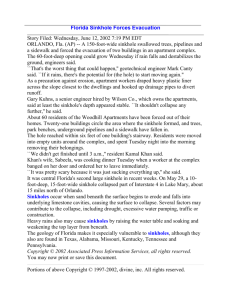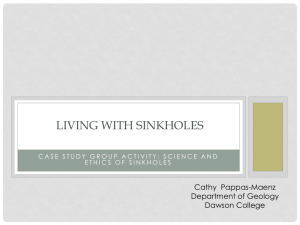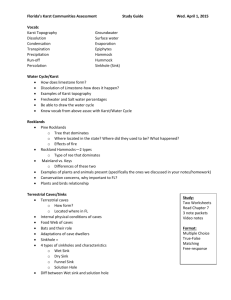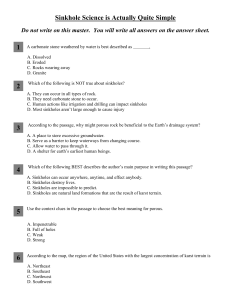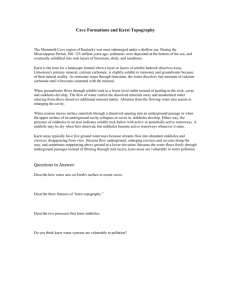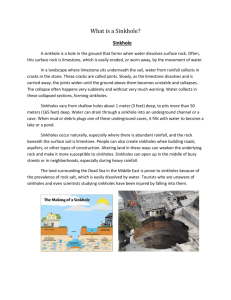Sinkhole Management for Agricultural Producers
advertisement
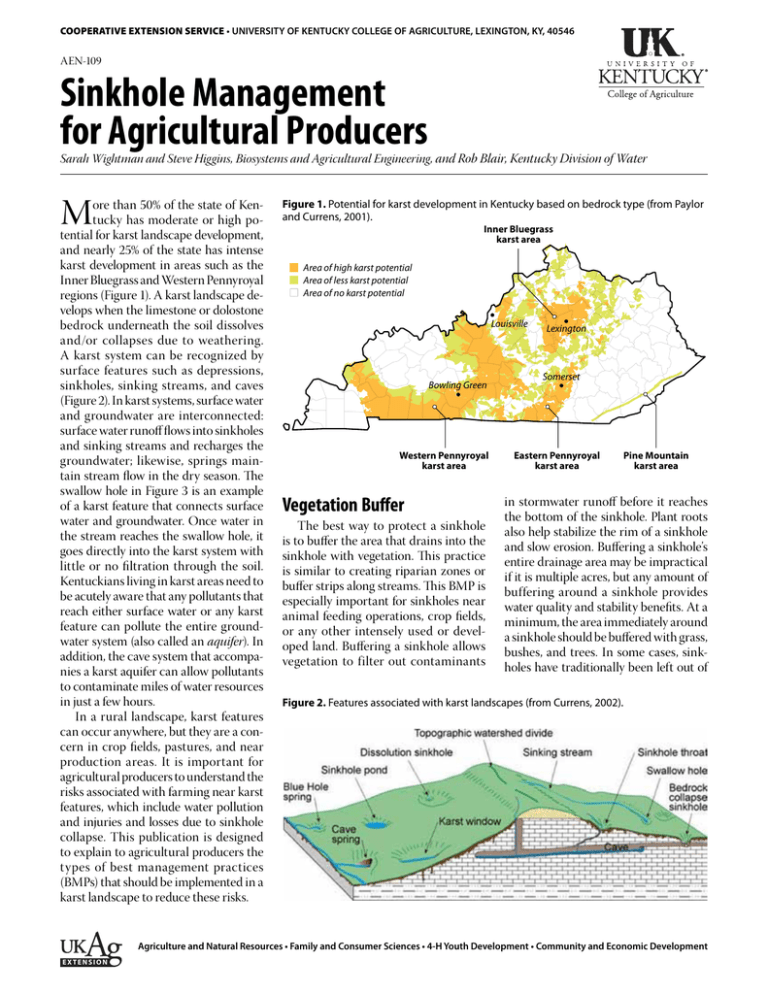
COOPERATIVE EXTENSION SERVICE • UNIVERSITY OF KENTUCKY COLLEGE OF AGRICULTURE, LEXINGTON, KY, 40546 AEN-109 Sinkhole Management for Agricultural Producers Sarah Wightman and Steve Higgins, Biosystems and Agricultural Engineering, and Rob Blair, Kentucky Division of Water M ore than 50% of the state of Kentucky has moderate or high potential for karst landscape development, and nearly 25% of the state has intense karst development in areas such as the Inner Bluegrass and Western Pennyroyal regions (Figure 1). A karst landscape develops when the limestone or dolostone bedrock underneath the soil dissolves and/or collapses due to weathering. A karst system can be recognized by surface features such as depressions, sinkholes, sinking streams, and caves (Figure 2). In karst systems, surface water and groundwater are interconnected: surface water runoff flows into sinkholes and sinking streams and recharges the groundwater; likewise, springs maintain stream flow in the dry season. The swallow hole in Figure 3 is an example of a karst feature that connects surface water and groundwater. Once water in the stream reaches the swallow hole, it goes directly into the karst system with little or no filtration through the soil. Kentuckians living in karst areas need to be acutely aware that any pollutants that reach either surface water or any karst feature can pollute the entire groundwater system (also called an aquifer). In addition, the cave system that accompanies a karst aquifer can allow pollutants to contaminate miles of water resources in just a few hours. In a rural landscape, karst features can occur anywhere, but they are a concern in crop fields, pastures, and near production areas. It is important for agricultural producers to understand the risks associated with farming near karst features, which include water pollution and injuries and losses due to sinkhole collapse. This publication is designed to explain to agricultural producers the types of best management practices (BMPs) that should be implemented in a karst landscape to reduce these risks. Figure 1. Potential for karst development in Kentucky based on bedrock type (from Paylor and Currens, 2001). Inner Bluegrass karst area Area of high karst potential Area of less karst potential Area of no karst potential Louisville Bowling Green Western Pennyroyal karst area Vegetation Buffer The best way to protect a sinkhole is to buffer the area that drains into the sinkhole with vegetation. This practice is similar to creating riparian zones or buffer strips along streams. This BMP is especially important for sinkholes near animal feeding operations, crop fields, or any other intensely used or developed land. Buffering a sinkhole allows vegetation to filter out contaminants Lexington Somerset Eastern Pennyroyal karst area Pine Mountain karst area in stormwater runoff before it reaches the bottom of the sinkhole. Plant roots also help stabilize the rim of a sinkhole and slow erosion. Buffering a sinkhole’s entire drainage area may be impractical if it is multiple acres, but any amount of buffering around a sinkhole provides water quality and stability benefits. At a minimum, the area immediately around a sinkhole should be buffered with grass, bushes, and trees. In some cases, sinkholes have traditionally been left out of Figure 2. Features associated with karst landscapes (from Currens, 2002). Agriculture and Natural Resources • Family and Consumer Sciences • 4-H Youth Development • Community and Economic Development EXTENSION allow contaminated runoff and debris to enter the karst system. Additionally, pouring cement or concrete into a sinkhole in an attempt to seal it is strongly discouraged and will cause more problems and expense in the long run. Stormwater Diversion Figure 3. This swallow hole connects the surface stream to the underground water system and does not filter out contaminants, which allows them to enter the system rapidly. the production area and may already have some vegetation growing around them, but this traditional vegetative buffer can often be expanded or more intensely planted. If it becomes necessary to remove invasive species or toxic plants near sinkholes, use mechanical means or spot applications of herbicides that are considered safe around water sources. Sinkhole buffers in crop areas may require the use of herbicide-ready plants or species that can tolerate the herbicides used on the crops. Stabilization Sinkhole formation occurs as a result of soil erosion from both the surface and subsurface. Surface runoff—especially fast-moving water—erodes soil from the sinkhole surface and carries it underground. As that runoff moves through the sinkhole and into bedrock fractures, it also carries soil away from the bedrock, resulting in erosion of both the surface and subsurface. These erosive forces of surface runoff can weaken the overlying soil to the point that a sinkhole will begin to collapse. When this weakening occurs, it is very important to stabilize the sinkhole without sealing it off. Various methods can be used to stabilize sinkholes safely and effectively. The following is a general description of one recommended stabilization method. First, excavate the bottom of the sinkhole down to bedrock, exposing the fracture or dissolution cavity. Fill the sinkhole with a layer of rocks large enough to bridge the gap and provide a foundation for backfill. Then, fill the rest of the sinkhole with shot rock and large gravel up to the land surface. When it is impractical or impossible to excavate to bedrock, it is acceptable to backfill the sinkhole completely with shot rock and large gravel; however, settling should be expected, and additional fill may be required over the years. After backfilling is completed, a vegetative buffer as described above should be established or repaired. Detailed plans for sinkhole stabilization can be obtained from the Kentucky Geological Survey website (http://www.uky.edu/KGS/) or requested by telephone at (859)323-0526. In general, the use of standpipes or the drilling of dry wells is discouraged, as they can cause flooding problems and 2 Disturbances such as soil or water movement near sinkholes can cause them to become unstable, which can result in the sinkhole deepening or widening and in some cases sudden surface collapse. Also, as more water enters a sinkhole, the potential for water resource contamination greatly increases (Figure 4). Landowners should attempt to reduce and/or slow down the water flowing into sinkholes by creating grassed waterways or placing riprap in ditches and gullies leading to sinkholes. In cases where water flows by sheet action, it is best to create a large vegetative buffer. As a last resort, landowners may want to install diversion ditches or grassed waterways that direct water away from the sinkhole, which slows the growth of the sinkhole and lessens the potential for water pollution. However, when diverting water, producers must consider where the runoff will be diverted to ensure that it doesn’t cause additional erosion or water quality problems. Figure 4. Water was channeled into this sinkhole, causing it to grow deeper and wider. Figure 5. Manure dumped in this sinkhole can contaminate ground and surface water with both pathogens and nutrients. Figure 6. Dumping trash in a sinkhole can pollute ground and surface water. Dumping Livestock Exclusion Pesticides and Fertilizers Traditionally, sinkholes have not been used in agricultural operations; however, since space often becomes limited as operations grow, some producers have converted sinkholes and other karst features into dumps for muck, household and shop wastes, fencing material, and any other inconvenient waste (Figures 5 and 6). Placing contaminants in a sinkhole can contaminate groundwater often used for irrigation, livestock water sources, and drinking water for rural communities. This means that a depression or sinkhole should never be used as an open dump. Any waste, including dead animals, household trash, and construction debris, should not be placed in a sinkhole or even buried within 100 feet of a sinkhole, as these materials can release pollutants underground that could then easily be transmitted to water resources through the karst system. Additionally, grey water, septic system waste, or surface drainage should never be diverted to a sinkhole. Only sand, soil, rock, gravel, or untreated wood should be deposited in a sinkhole; anything else should be removed immediately and disposed of properly. Finally, never plug a sinkhole. Sinkholes in pastures are common in Kentucky. Livestock should be excluded from sinkholes and other karst features by fencing off the sinkhole’s drainage area. Many Central Kentucky horse farmers already fence off sinkholes to protect animals from injury, but excluding livestock also protects water quality by preventing manure, sediment, and other pollutants from entering the sinkhole. Sinkholes should be fenced at least 25 feet out from the top rim of the depression, since it may be impractical to fence off the entire drainage area (Figure 7). In cropped areas, sinkholes should be protected with a vegetative buffer. This buffer should be marked to prevent it from being sprayed before nearby row crop or forage planting. Although this practice enhances water quality by reducing herbicide and fertilizer (inorganic and organic) applications, it can also save money and prevent equipment damage that frequently occurs near sinkholes and other karst features. New pesticide and fertilizer storage facilities should be located at least 100 feet from sinkholes, other karst features, and surface water bodies, and chemicals should never be mixed near a sinkhole. Figure 7. Livestock are excluded from these sinkholes, which protects animals and water quality. 3 Underground and Aboveground Storage Tanks An underground storage tank is any tank that has at least 10% of its volume underground. An aboveground tank is located entirely aboveground. These tanks can contain a variety of substances, but among the most common on agricultural operations are petroleum products. To minimize the impact of potential leaks, these tanks should be located as far as possible from sinkholes. Underground tanks should be equipped with secondary containment or leak detection devices as a safeguard in the event of a release from the primary tank. Aboveground tanks should have secondary containment, such as a poured concrete floor and containment berms, placed under and around them to ensure that leaks and spills are contained. Regulations Sinkhole treatment or closing any kind of karst opening is allowed by law but should be accomplished using technical assistance from the Natural Resources Conservation Service (NRCS). For more information see the NRCS Conservation Practice Standard Sinkhole and Sinkhole Area Treatment Code 527 or contact your local NRCS office. Resources See the following publications from the Kentucky Cooperative Extension Service: Assessing and Reducing the Risk of Groundwater Contamination from Petroleum Product Storage (IP-42) BMP #4: Sinkholes (FOR-67) Household Waste Management: Hazardous Waste (HENV-104) Household Waste Management: Recycle (HENV-103) On-Farm Composting of Animal Mortalities (ID-166) On-Farm Disposal of Animal Mortalities (ID-167) Vegetative Filter Strips for Livestock Facilities (ID-189) References Currens, J.S. 2002. Kentucky is Karst Country: What you should know about sinkholes and springs. Kentucky Geological Survey. Information Circular 004, Series 12, 35 pp. Kentucky Agriculture Water Quality Authority. 2010. The Kentucky Agriculture Water Quality Plan. Available at: http://conservation.ky.gov/Pages/ AgricultureWaterQuality.aspx Paylor, R. and Currens, J. C. 2001. Karst Occurrence in Kentucky. Kentucky Geological Survey. Map and Chart 33, Series 12. Educational programs of Kentucky Cooperative Extension serve all people regardless of race, color, age, sex, religion, disability, or national origin. Issued in furtherance of Cooperative Extension work, Acts of May 8 and June 30, 1914, in cooperation with the U.S. Department of Agriculture, M. Scott Smith, Director of Cooperative Extension Programs, University of Kentucky College of Agriculture, Lexington, and Kentucky State University, Frankfort. Copyright © 2011 for materials developed by University of Kentucky Cooperative Extension. This publication may be reproduced in portions or its entirety for educational or nonprofit purposes only. Permitted users shall give credit to the author(s) and include this copyright notice. Publications are also available on the World Wide Web at www.ca.uky.edu. Issued 10-2011
